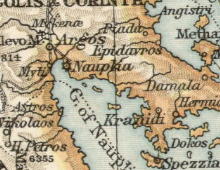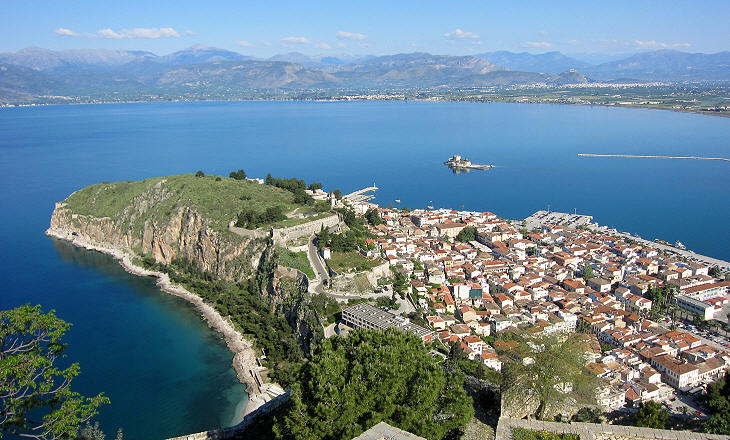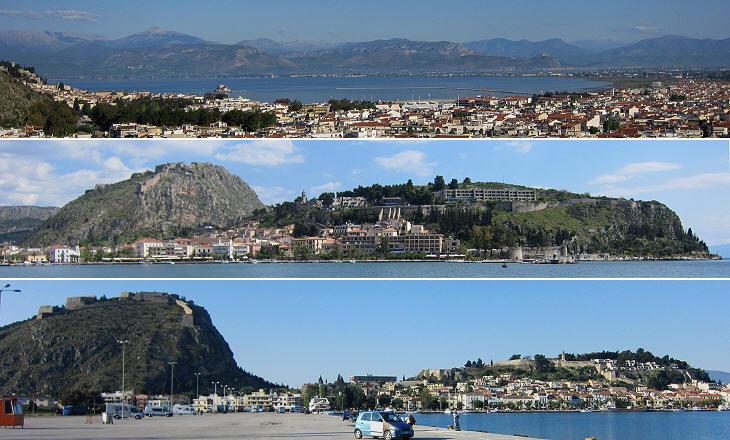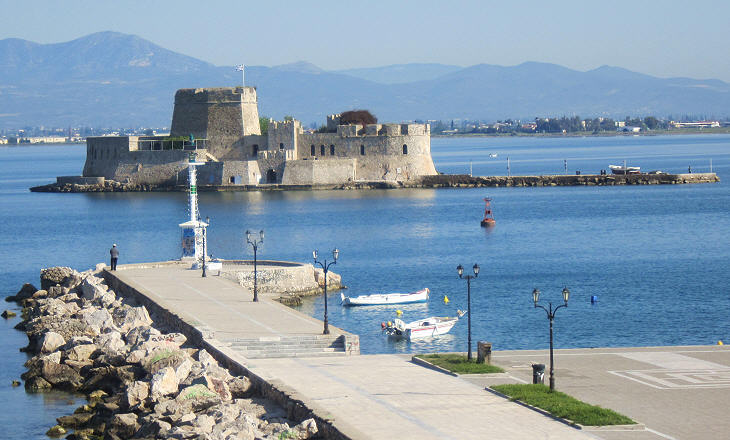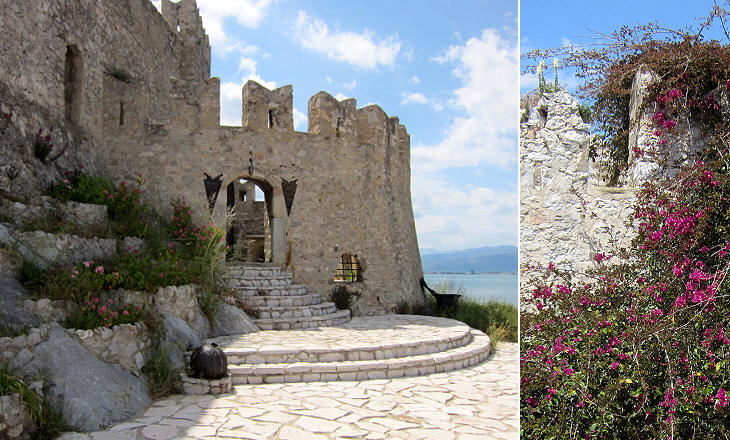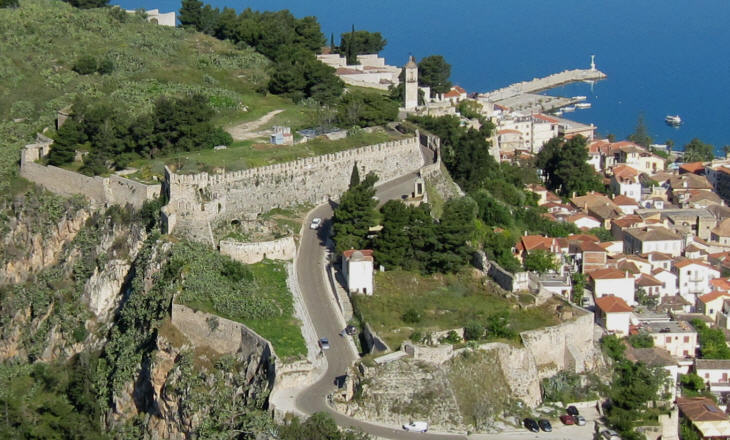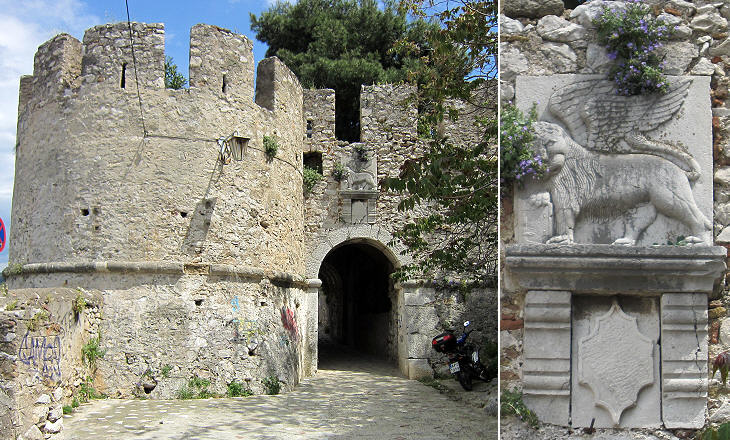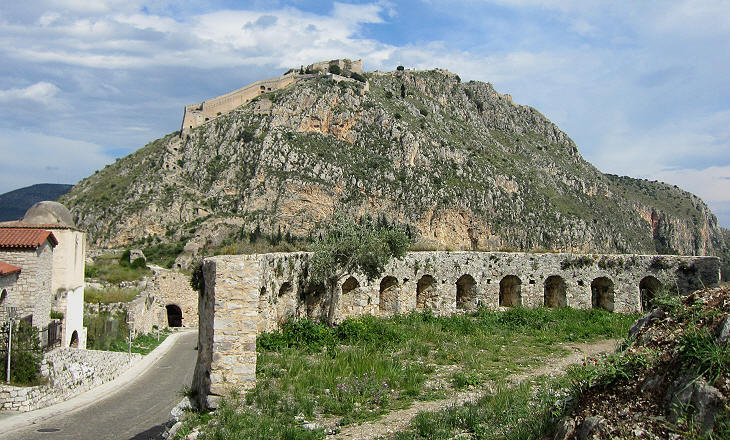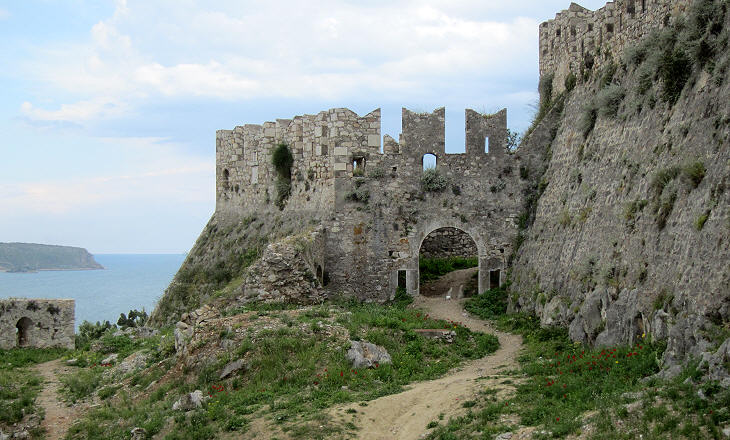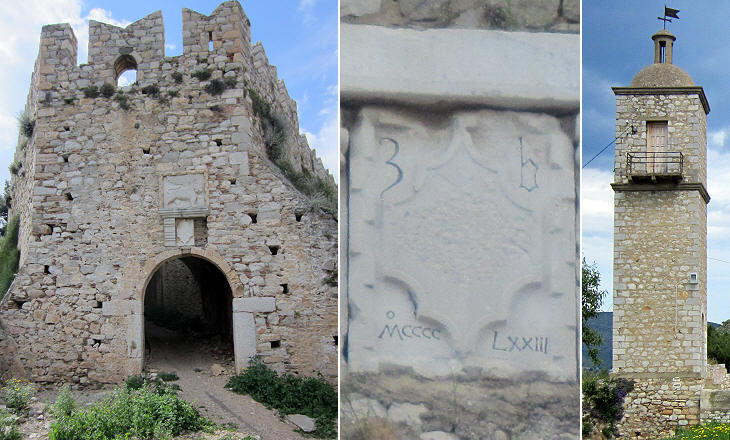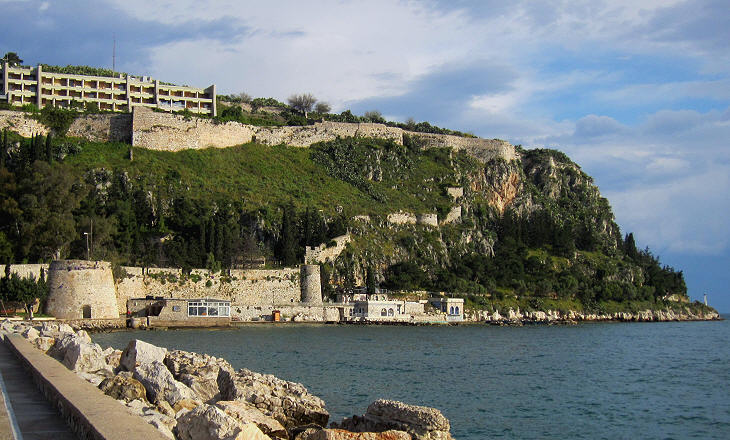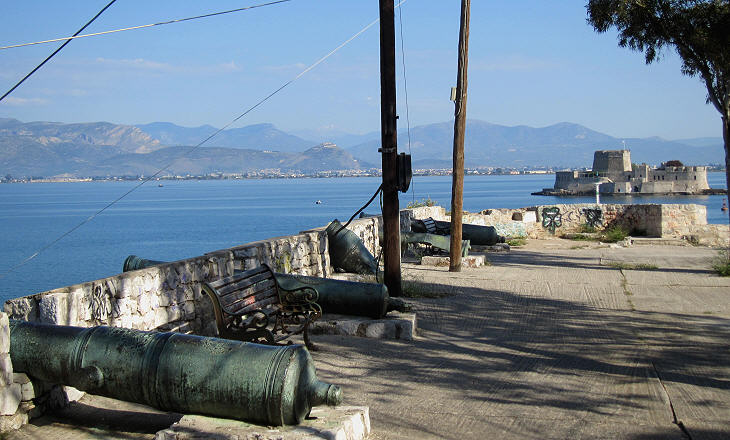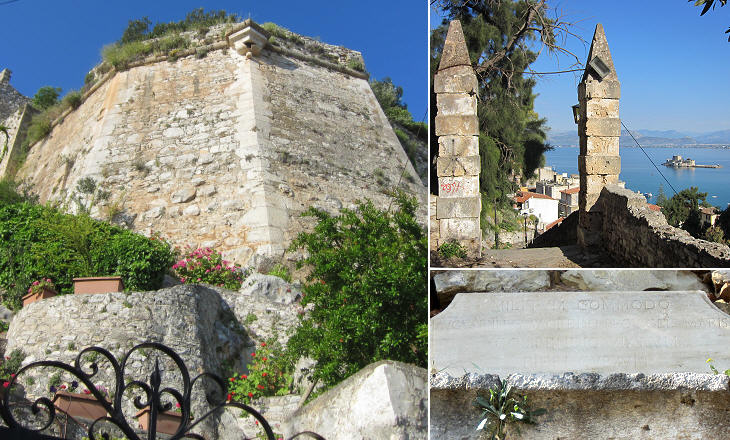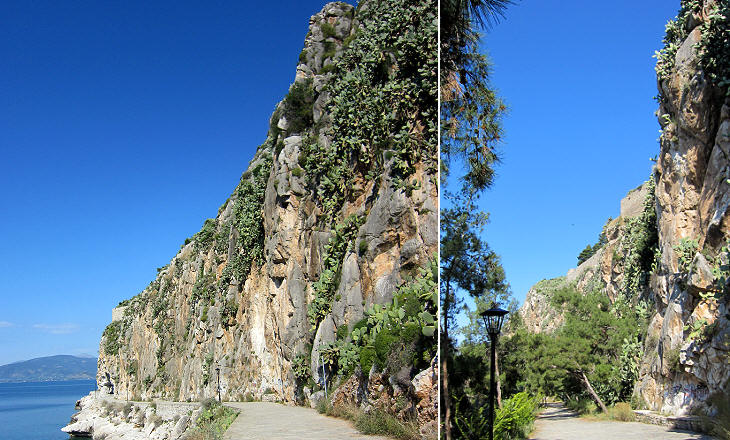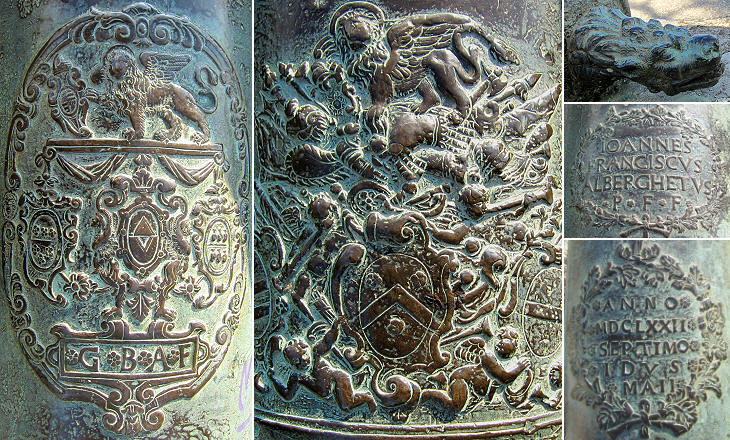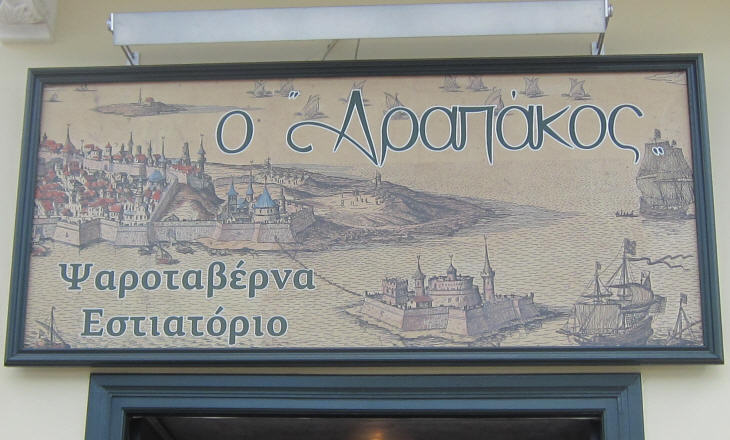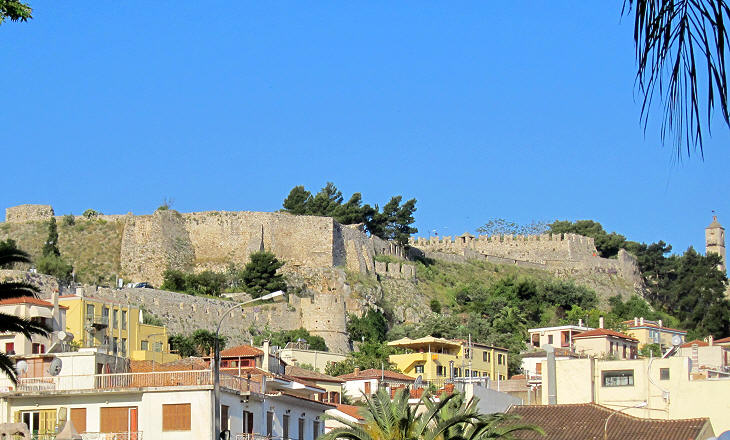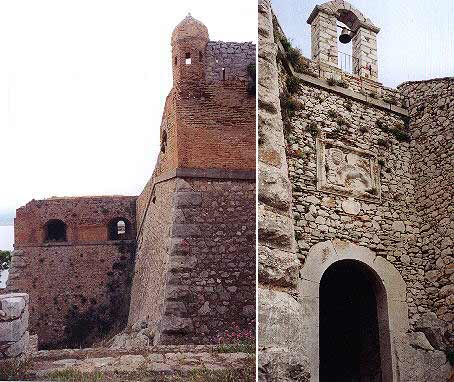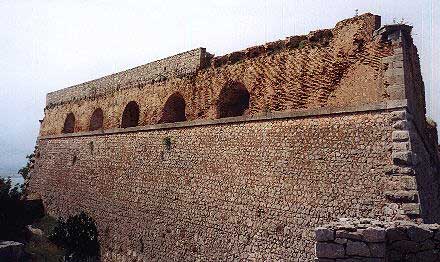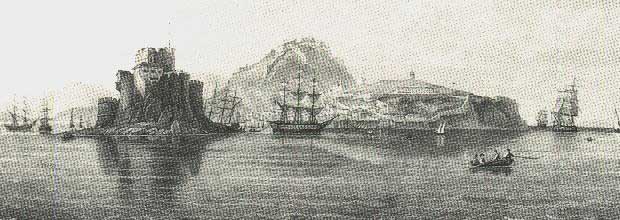  What's New! Detailed Sitemap All images © by Roberto Piperno, owner of the domain. Write to romapip@quipo.it. Text edited by Rosamie Moore. |
Nafplion, fell to the Venetians
in the late 14th century, was held by the Turks from 1540 to 1686, then by the Venetians to
1715 (when it was called Napoli di Romania), and then again by the Turks to 1822, when it was finally captured by the Greeks and became the
first capital of the Kingdom of Greece.
Nafplion, fell to the Venetians in the late 14th century, was held by the Turks from 1540 to 1686, then by the Venetians to 1715 (when it was called Napoli di Romania), and then again by the Turks to 1822, when it was finally captured by the Greeks and became the first capital of the Kingdom of Greece.
Bourtzi or Castel da Mar (Sea Castle) Built in 1471 by Antonio Gambello, an architect from Bergamo, it was at first a single tower
on a tiny islet. After Francesco Morosini captured it for Venice in 1686, a tower and bastions
were added, giving it the ship-like appearance it has today. It was further strengthened by the Turks who
closed the entrance to the harbour by laying a chain from Bourtzi to the pier.
Acronauplia is the fortified hill above Nafplion. The present castle was built in 3 stages. The first construction stage was performed in Byzantine times, when the hill was surrounded by walls in order to protect it from repeated attacks by pirates. After French Crusaders occupation of the town following their seizure of Constantinople in 1204, Nafplion played only a minor role as the port of Argos. The arrival in Nafplion of the Venetians in the year 1377, changed the situation completely. The Venetians needed a safe haven to upload and download their ships, but also just to rest on the route towards Constantinople or towards the Holy Land. In the year 1470 Giovanni Pasqualigo was sent from Venice to reinforce the walls of Acronauplia. At this time two round towers were added to reinforce the so called "Castel de' Franchi". During their second occupation the Venetians built a new rampart (bastione Grimani) to protect the town from attacks from the east.
The arrival in Nafplion of the Venetians in the year 1377, changed the situation completely. The Venetians needed a safe haven to upload and download their ships, but also just to rest on the route towards Constantinople or towards the Holy Land. In the year 1470 Giovanni Pasqualigo was sent from Venice to reinforce the walls of Acronauplia. At this time two round towers were added to reinforce the so called "Castel de' Franchi". During their second occupation the Venetians built a new rampart (bastione Grimani) to protect the town from attacks from the east.
The arrival in Nafplion of the Venetians in the year 1377, changed the situation completely. The Venetians needed a safe haven to upload and download their ships, but also just to rest on the route towards Constantinople or towards the Holy Land. In the year 1470 Giovanni Pasqualigo was sent from Venice to reinforce the walls of Acronauplia. At this time two round towers were added to reinforce the so called "Castel de' Franchi". During their second occupation the Venetians built a new rampart (bastione Grimani) to protect the town from attacks from the east.
The arrival in Nafplion of the Venetians in the year 1377, changed the situation completely. The Venetians needed a safe haven to upload and download their ships, but also just to rest on the route towards Constantinople or towards the Holy Land. In the year 1470 Giovanni Pasqualigo was sent from Venice to reinforce the walls of Acronauplia. At this time two round towers were added to reinforce the so called "Castel de' Franchi". During their second occupation the Venetians built a new rampart (bastione Grimani) to protect the town from attacks from the east.
The arrival in Nafplion of the Venetians in the year 1377, changed the situation completely. The Venetians needed a safe haven to upload and download their ships, but also just to rest on the route towards Constantinople or towards the Holy Land. In the year 1470 Giovanni Pasqualigo was sent from Venice to reinforce the walls of Acronauplia. At this time two round towers were added to reinforce the so called "Castel de' Franchi". During their second occupation the Venetians built a new rampart (bastione Grimani) to protect the town from attacks from the east. nd occupation the Venetians built a new rampart (bastione Grimani) to protect the town from attacks from the east.
The arrival in Nafplion of the Venetians in the year 1377, changed the situation completely. The Venetians needed a safe haven to upload and download their ships, but also just to rest on the route towards Constantinople or towards the Holy Land. In the year 1470 Giovanni Pasqualigo was sent from Venice to reinforce the walls of Acronauplia. At this time two round towers were added to reinforce the so called "Castel de' Franchi". During their second occupation the Venetians built a new rampart (bastione Grimani) to protect the town from attacks from the east.
The arrival in Nafplion of the Venetians in the year 1377, changed the situation completely. The Venetians needed a safe haven to upload and download their ships, but also just to rest on the route towards Constantinople or towards the Holy Land. In the year 1470 Giovanni Pasqualigo was sent from Venice to reinforce the walls of Acronauplia. At this time two round towers were added to reinforce the so called "Castel de' Franchi". During their second occupation the Venetians built a new rampart (bastione Grimani) to protect the town from attacks from the east.
The arrival in Nafplion of the Venetians in the year 1377, changed the situation completely. The Venetians needed a safe haven to upload and download their ships, but also just to rest on the route towards Constantinople or towards the Holy Land. In the year 1470 Giovanni Pasqualigo was sent from Venice to reinforce the walls of Acronauplia. At this time two round towers were added to reinforce the so called "Castel de' Franchi". During their second occupation the Venetians built a new rampart (bastione Grimani) to protect the town from attacks from the east.
The arrival in Nafplion of the Venetians in the year 1377, changed the situation completely. The Venetians needed a safe haven to upload and download their ships, but also just to rest on the route towards Constantinople or towards the Holy Land. In the year 1470 Giovanni Pasqualigo was sent from Venice to reinforce the walls of Acronauplia. At this time two round towers were added to reinforce the so called "Castel de' Franchi". During their second occupation the Venetians built a new rampart (bastione Grimani) to protect the town from attacks from the east.
The arrival in Nafplion of the Venetians in the year 1377, changed the situation completely. The Venetians needed a safe haven to upload and download their ships, but also just to rest on the route towards Constantinople or towards the Holy Land. In the year 1470 Giovanni Pasqualigo was sent from Venice to reinforce the walls of Acronauplia. At this time two round towers were added to reinforce the so called "Castel de' Franchi". During their second occupation the Venetians built a new rampart (bastione Grimani) to protect the town from attacks from the east.
The arrival in Nafplion of the Venetians in the year 1377, changed the situation completely. The Venetians needed a safe haven to upload and download their ships, but also just to rest on the route towards Constantinople or towards the Holy Land. In the year 1470 Giovanni Pasqualigo was sent from Venice to reinforce the walls of Acronauplia. At this time two round towers were added to reinforce the so called "Castel de' Franchi". During their second occupation the Venetians built a new rampart (bastione Grimani) to protect the town from attacks from the east.
The arrival in Nafplion of the Venetians in the year 1377, changed the situation completely. The Venetians needed a safe haven to upload and download their ships, but also just to rest on the route towards Constantinople or towards the Holy Land. In the year 1470 Giovanni Pasqualigo was sent from Venice to reinforce the walls of Acronauplia. At this time two round towers were added to reinforce the so called "Castel de' Franchi". During their second occupation the Venetians built a new rampart (bastione Grimani) to protect the town from attacks from the east.
The arrival in Nafplion of the Venetians in the year 1377, changed the situation completely. The Venetians needed a safe haven to upload and download their ships, but also just to rest on the route towards Constantinople or towards the Holy Land. In the year 1470 Giovanni Pasqualigo was sent from Venice to reinforce the walls of Acronauplia. At this time two round towers were added to reinforce the so called "Castel de' Franchi". During their second occupation the Venetians built a new rampart (bastione Grimani) to protect the town from attacks from the east. Palamidi The Venetians had conquered Nafplion by bombarding it from Mount Palamidi a high hill to the east of the town. To protect Nafplion from being bombarded again they built on this hill a very large fortress made of seven separate forts which could stand attack on their own. The 857 steps which lead to the first fort (dedicated to S. Andrea) offer breathtaking views over the town, the gulf and the mountains of Peloponnese. Today the forts are rather incongruously named after Achilles, Aiax and other heroes of Ancient Greece.
The Venetians made Nafplion the capital of their Greek possessions and Francesco Morosini died here in 1694. The new fortress had also the political objective of showing the strength and determination of Venice. However Venice failed to gain the support of the Greek population, in particular by leaving room to the Church for forcing conversions to Catholicism and by a rapacious fiscal policy. In spite of all its impressive walls, in 1715 Palamidi resisted the Turks for only a few days. The fall of Palamidi led to that of Nafplion and of the entire Peloponnese. One of the forts was used as a prison and Palamidi was garrisoned until the 1970s.
Excerpts from Memorie Istoriografiche del Regno della Morea Riacquistato dall'armi della Sereniss. Repubblica di Venezia printed in Venice in 1692 and related to this page:
Introductory page on the Venetian Fortresses Pages of this section: On the Ionian Islands: Corfù (Kerkyra) Paxo (Paxi) Santa Maura (Lefkadas) Cefalonia (Kephallonia) Asso (Assos) Itaca (Ithaki) Zante (Zachintos) Cerigo (Kythera) On the mainland: Butrinto (Butrint) Parga Preveza and Azio (Aktion) Vonizza (Vonitsa) Lepanto (Nafpaktos) Atene (Athens) On Morea: Castel di Morea (Rio), Castel di Rumelia (Antirio) and Patrasso (Patra) Castel Tornese (Hlemoutsi) and Glarenza Navarino (Pilo) and Calamata Modon (Methoni) Corone (Koroni) Braccio di Maina, Zarnata, Passavà and Chielefà Mistrà Corinto (Korinthos) Argo (Argos) Napoli di Romania (Nafplio) Malvasia (Monemvassia) On the Aegean Sea: Negroponte (Chalki) Castelrosso (Karistos) Oreo Lemno (Limnos) Schiatto (Skiathos) Scopello (Skopelos) Alonisso Schiro (Skyros) Andro (Andros) Tino (Tinos) Micono (Mykonos) Siro (Syros) Egina (Aegina) Spezzia (Spetse) Paris (Paros) Antiparis (Andiparos) Nasso (Naxos) Serifo (Serifos) Sifno (Syphnos) Milo (Milos) Argentiera (Kimolos) Santorino (Thira) Folegandro (Folegandros) Stampalia (Astipalea) Candia (Kriti) You may refresh your knowledge of the history of Venice in the Levant by reading an abstract from the History of Venice by Thomas Salmon, published in 1754. The Italian text is accompanied by an English summary. Clickable Map of the Ionian and Aegean Seas with links to the Venetian fortresses and to other locations (opens in a separate window) |
